

![]()
This Website was created in the hopes of keeping alive the memory of Ensign Richard Alonzo Jaccard and the ship named in his honor. It is difficult to accept the fact that 60 years have now passed since the Battle of Midway, and the death of this brave Naval Aviator, but time waits for no man. The month of June, 2002 marks the sixtieth anniversary of this horriffic battle in the Pacific, which has gone down in Naval history as one of the most decisive battles fought in World War II.
Therefore, This Yeoman is very proud to present this Website to the Honor and Memory of Ensign Richard Jaccard and the USS JACCARD DE-355. May he, his sacrafice, and the sacrafices of all those who fought in WWII never be forgotten. This site's Mission, therefore, is to that end.
Richard was born 1 July 1918, in Troy, Mo., and enlisted in the Naval Reserve 29 October 1940. He later underwent flight training and upon graduation was commissioned Ensign 27 September 1941. Reporting to famed carrier ENTERPRISE (CV-6) in April 1942, Ens. Jaccard took part 4 June 1942 in one of the most important battles in all naval history, the Battle of Midway.
As American carrier groups moved to meet the Japanese thrust at Midway, Jaccard, as part of Scouting Squadron 6, attacked enemy carriers during the morning, knocking out AKAGI and KAGA. That afternoon the squadron carried out another devastating attack, sinking carrier HIRYU. For his part in a great victory, Jaccard was awarded the Navy Cross.
Following further missions with Scouting Squadron 6, Jaccard was transferred to Bombing Squadron 6 in WASP (CV-7). While supporting the Guadalcanal campaign from the carrier, Ens. Jaccard was killed when WASP was torpedoed and sunk 15 September 1942.
Richard A. Jaccard is pictured here as a Naval Midshipman. We are seeking more personal data on the man as we continue to build this memorial to the Ship and the Man. Richard was a member of Scouting Squadron 6 as stated above, and we have included a picture of the brave men that made up this squadron here...
We are fortunate to report that we have located several family members of Richard's who are willing to contribute to this Memorial, and we await more from them.
We wish to thank Jack Parker for his help in sending these photos, as we are so happy to keep the memory of this naval Aviator and Hero alive.
Thanks to the Internet, we are able to accomplish much of this task, but it is, as always a joint venture, where we must enlist the help of all involved and all who are willing to step forward.
Ensign Jaccard was killed in the performance of his duty aboard the WASP CV-7, when she was sunk by enemy torpedoes. It would be a much greater tragedy if in the course of 60 years, we have forgotten utterly his sacrafice, or the sacrifice of all the men who went to War in WWII (or any war) and were, in the end, forgotten. This should not be; this will not be, if we, who have the wherewithall to keep the memories alive.
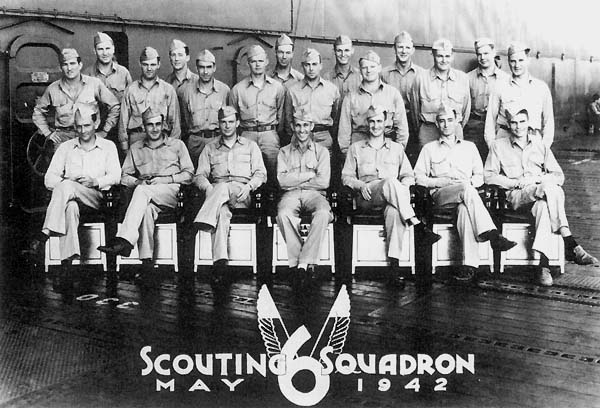
The Fatal Action that took Ens. Jaccard's Life
To know Ensign Jaccard, you have to know the power behind him, that drove him to Action. In this case, the Power was his Desire to do what's right and his Courage that drove him to action. He was a man with the 'Right Stuff' character, that is woven into the fabric of all Naval Aviators. Ensign Jaccard received more of this unique 'Power' from flying one of the Navy's deadliest aircraft of the World War II era, the Douglas Fighter/Dive Bomber, SBD-3 Dauntless.
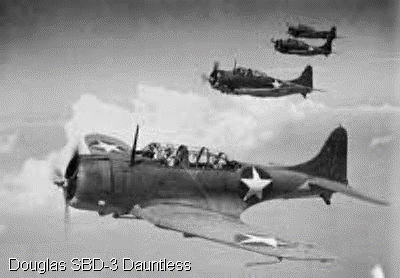 |
I have sought to bring circumstances surrounding Ensign Jaccard's loss forefront and to mind again, after nearly 60 years, so that we would, as beneficiaries of these intrepid young men, be more appreciative of what these heroes have done for us, so that we will never allow history to repeat itself again.
The following information was sleuthed and contributed by Rudy Friederich, Coordinator, Aircraft Carrier Study Group Knoxville, Tennessee, who answered my plea to get more information on Ensign Jaccard, and the circumstances around his demise, please join with me in gratitude to Rudy for the following...
"Richard E. Jaccard, a Kansas man. tall, lean, humorous. Nickname Dick. He was flying a Dauntless dive bomber, at Midway in Scouting Six squadron, off ENTERPRISE, CV 6 at Midway Battle. He was flying in a 4-plane section led by LT Earl Gallagher, CO, of Scouting Six. (Scouts and Bombers flew the same plane and apparently remnants were interchanged after Midway to VB-6). This was the evening strike from ENTERPRISE. Gallagher and second plane dived on Hiryu, Japanese carrier, and missed. Hiryu had turned shaprply. Jaccard, third man down, scored near the bow. (I can assume that it was this action in which he received the Navy Cross). He was to damage Hiryu who had a deck ready to launch her few remaining aircraft.
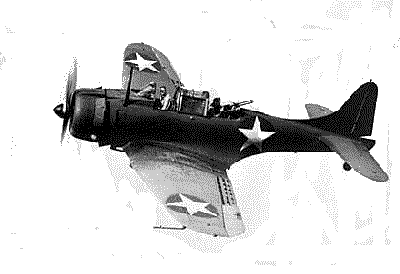 |
"With ENTERPRISE in for repairs, remnants of VB-6, 12 planes, pilots, were sent to Efate, New Hebrides as VB-6. They were to operate with a Marine fighting squadron there ashore. A call came from WASP CV-7 for 4 bombing planes, pilots. Jaccard lost the draw and was sent to WASP. Jaccard was asleep in his bunk when the torpedo hits obliterated the officers' quarters."
* From the archives of the Aircraft Carrier Study Group.
![]()
Some Brave young pilots attached to Squadrons
in
USS Lexington CV-16, just after the Marshall Islands
Attack, November 1943 and USS Hancock CV-19, 1944
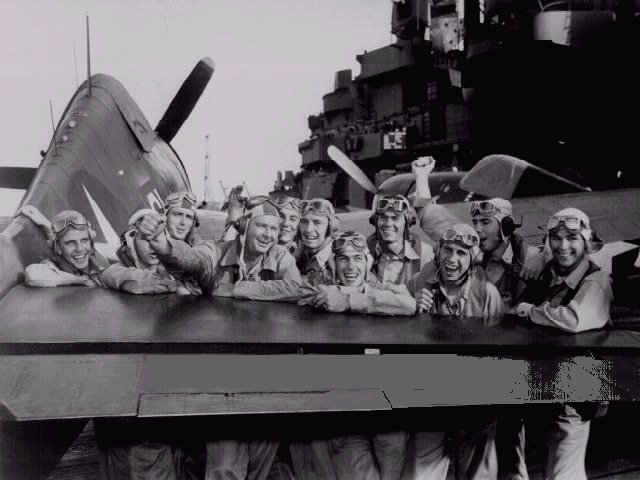 |
I have included this picture to show you what great kids these pilots were. And they were just kids, some not more than 19 years old.. Kids who became men overnight... kids born of a tradition; born to a country where freedom was worth risking their lives for; kids born of bravery, and destined for Glory. It was nearly 60 years ago now, but to those who lived it, a mere thought away. May God keep these intrepid souls in his Heart and Mind forever! They will be in this Yeoman's heart, no doubt about it!
Some Lexington Facts: The fifth Lexington (CV-16) was laid down as Cabot 15 July 1941 by Bethlehem Steel Co., Quincy, Mass., renamed Lexington 16 June 1942 to honor it's predecessor, USS Lexington CV-2 lost on 8 May 1942.
Lexington CV-2's namesake, the "Blue Ghost" was launched 23 September 1942; sponsored by Mrs. Theodore D. Robinson; and commissioned 17 February 1943, Capt. Felix B. Stump in command. After Caribbean shakedown and yard work at Boston, Lexington sailed for Pacific action via the Panama Canal, arriving Pearl Harbor 9 August 1943. She raided Tarawa in late September and Wake in October, then returned Pearl Harbor to prepare for the Gilbert Islands operation. From 19 to 24 November she made searches and flew sorties in the Marshalls, covering the landings in the Gilberts. Her aviators downed 29 enemy aircraft on 23 and 24 November. (now we know why they were so jubilant)
Dictionary of American Naval Fighting Ships Info on Lexington
USS Lexington CV-16 Association
USS Lexington CV-16 Museum on the Bay
![]()
Some
Historical Data on the USS Hancock CV-19
and her contribution to the War Effort in the Pacific (CD-ROM)
![]()
Get some background on what Ens. Jaccard encountered during the Battle of Midway, by visiting the Battle of Midway, June 3-6, 1942.
The breakdown of the Carrier Air Groups are on this page, and you will find Ens. Jaccard, assigned to CEAG Section, VS-6 (Scouting Squadron 6), in Enterprise, flying a SBD-3, fuselage #4563, S-11. This information is found at the above site, on this page.
These are some examples of the SBD-3 Dauntless by Douglas Aircraft, which Ens. Jaccard flew as a pilot with Scouting Squadron 6 (VS-6)...
About this Plane...
![]() Flight Journal - SBD-3 Dauntless
Flight Journal - SBD-3 Dauntless![]()
![]() A close-up, Top View of the SBD-3 Dauntless
A close-up, Top View of the SBD-3 Dauntless![]()
![]()
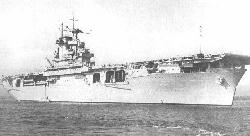 |
Some history about the USS WASP CV-7, the ship on which Ens. Jaccard was finally attached, with VS-6, and where he lost his life, when Wasp was torpedoed by a Japanese submarine...
USS WASP (CV-7) as she was, on December 7th, 1941...
The Wasp was built at Bethlehem Shipbuilding Corp, Quincy, Massachusetts. Her keel was laid down on 1 Apr 36. She was launched 4 Apr 39 and commissioned on 25 Apr 40.
USS Wasp was at anchor in Grassy Bay, Bermuda on 7 Dec 41. The Wasp Air Group consisted of:
Fighting Squadron Seventy One (VF-71) with 18 Grumman F4F-3 Wildcats
Fighting Squadron Seventy Two (VF-72) with 17 Grumman F4F-3 Wildcats, 2 Vought SB2U-2 Vindicators and 1 North American SNJ-3
Scouting Squadron Seventy One (VS-71) with 4 Vought SB2U-1 and 13 SB2U-2 Vindicators and 2 Douglas TBD-1 Devastators
Scouting Squadron Seventy Two (VS-72) with 18 Vought SB2U-3 Vindicators
USS Wasp was hit by two torpedoes fired from the Japanese submarine I-19 on 15 Sep 42 while operating off Guadalcanal Island in the Solomon Islands. The flaming hull was torpedoed and sunk by the U.S. destroyer USS Landsdowne later that day. Her name was struck from the Naval Register on 2 Nov 42
Yet More on the USS WASP CV-7 from Carrier Capsules
by Rudy Friederich, Coordinator, Aircraft Carrier Study Group
![]()
Visit Sandcastle V.I - Carriers proving
their worth
(Click the picture of WASP here)
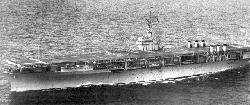 |
![]() Chapter 2 - Action at Guadalcanal
Chapter 2 - Action at Guadalcanal![]()
NavSource Online:
![]() Aircraft Carrier Photo Archive
Aircraft Carrier Photo Archive ![]()
CV-7 USS WASP
![]()
The Fateful Battles of the Solomon Islands Invasion
For some history about the Battles of Midway, Tarawa and The invasion of Guadalcanal, please visit...
![]() War in the Pacific - the Marines in WWII
War in the Pacific - the Marines in WWII![]()
![]()
Action in the South Pacific and
Other Interesting WWII Links
![]() United States Navy Aircraft Carriers on December
7, 1941
United States Navy Aircraft Carriers on December
7, 1941![]()
![]()
![]() The Northern Mariana Islands and WWII
The Northern Mariana Islands and WWII![]()
also represented on the USS Indianapolis
CA-35 - Ed Jones Memorial CD-ROM Site and
the USS Indianapolis CA-35
Ed Jones Memorial on the Internet
![]()
![]() The World at War - The Invasion of Saipan,
The World at War - The Invasion of Saipan, ![]()
Tinian and Guam - June 1944
![]()